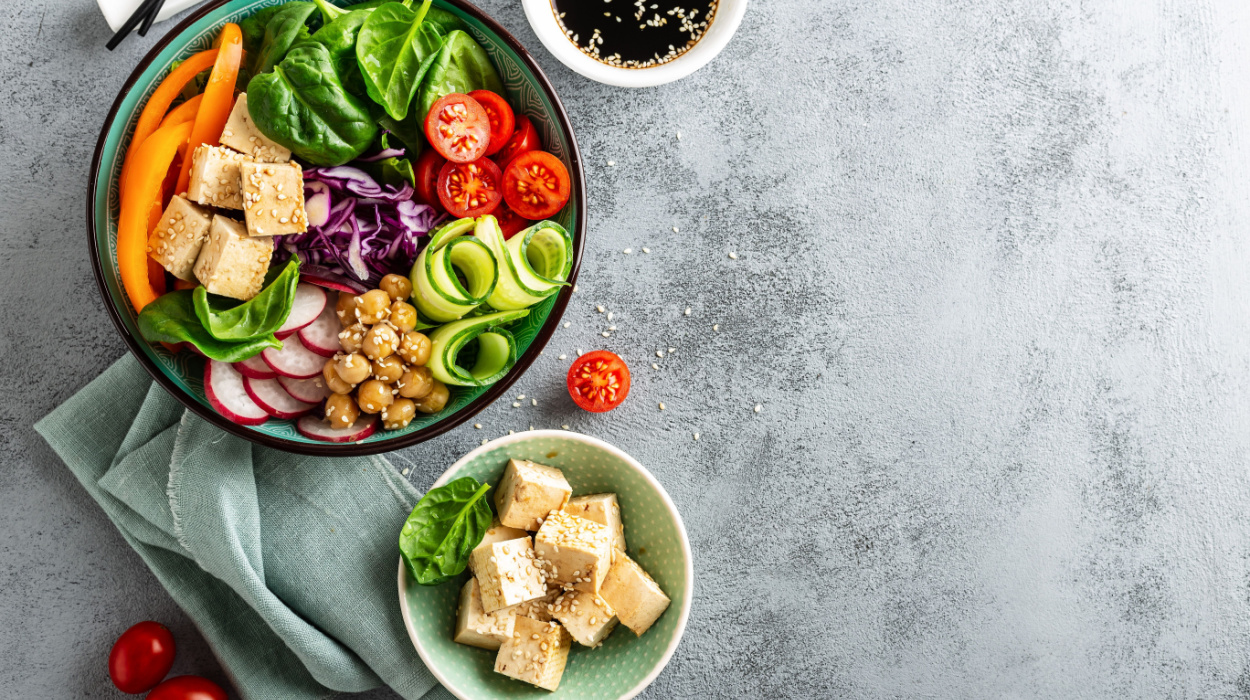Obesity has become a global health issue.[1] Modern lifestyles create a challenging atmosphere to maintain good health or improve it. Learning to manage a work-life balance, eating healthy, and exercising regularly is no small task.
How do you remember or have time to do all the things experts tell you to do to be a healthy person? Are you drinking enough water and getting adequate rest?
Meal planning can help ensure you consume healthy meals and manage caloric intake on a regular basis. This involves deciding what ingredients you will need for the week, preparing parts of the meals early, and storing them for a later meal.
Therefore, when you’re ready to eat your items are quick to assemble and consume for a delicious meal. Let us discuss some recipe ideas for low-calorie meals for weight loss.
Best Low Calorie Meals For Weight Loss
- Burrito or Buddha Bowl.
- Oven Roasted Veggies with Salmon or Tofu.
- Three-Bean Chili.
- Pasta with White Beans and Veggies.
- Tofu Stir Fry.
Low-Calorie Meals For Weight Loss
A common misconception about low-calorie meals is that you must eat a smaller amount of food to keep the calorie count low. However, you can create a calorie deficit and enjoy easy low-calorie meals for weight loss.
This might involve filling your plate with mostly plants and eating a larger volume of food as compared to a typical Western meal[2] – consisting of nutrient-poor foods high in fat and calories. Consider including vegetables, fruits, and beans as they are low-calorie foods with a higher water and fiber[3] content making them satisfying and supportive for weight loss.
You may equate low-calorie meals with being unsatisfying or tasteless. Increasing your intake of vegetables, beans, and lean protein will help keep your meals low-calorie while utilizing fresh herbs and spices can help to add flavor, depth, and additional health benefits.[4]
Creativity and variety are key factors in making tasteful, nutritious, and satisfying meals. You may need to substitute[5] more nutrient-dense foods in your favorite recipes to align the meal with your weight loss journey.
Do not be afraid of carbs. They provide energy and are an important component of a healthy diet. Eat complex carbohydrates more than simple carbs to help you reach your weight loss goals.
The five recipe suggestions below are healthy low-calorie meals for weight loss that can be modified to your tastes.
Burrito Or Buddha Bowl

Bowls are easy low-calorie high-protein meals for weight loss. You start with a base of greens and build from there.
A burrito-style bowl contains:
- Mixed greens like spinach and arugula.
- Brown rice or cauliflower rice.
- Black beans.
- Fresh tomato salsa.
- Assorted bell peppers.
- Onion, avocado, and jalapenos.
- Tofu or chicken.
- Top with plant-based or low-fat shredded cheese, fresh cilantro, and Greek yogurt.
Ingredients of a Buddha bowl may include:
- Greens as a base.
- Quinoa.
- Garbanzo beans.
- Pickled onions or cauliflower.
- Chopped carrots and red bell peppers.
- Tofu or chicken.
- Cashews.
Each ingredient is placed on top of the greens. These healthy meal options offer every essential nutrient including fiber, protein, healthy fats, and complex carbs.
Oven Roasted Veggies And Salmon Or Tofu
This is one of the best healthy low-calorie meal recipes for weight loss. Ingredients can be roasted in the oven or on a grill with minimal or no oil.
The variety of ingredients in this recipe is countless. Below are some combinations to try with your choice of lean protein.
- Broccoli and cauliflower with lemon zest, black pepper, and garlic.
- Squash, tomatoes, and onions with crushed red pepper, basil, and oregano.
- Sweet potatoes and kale or spinach with ginger and turmeric.
- Red-skinned potatoes and green beans with rosemary and thyme.
The key is to experiment with different flavors to optimize your nutritional benefits. These low-calorie dinners can be prepared with dried or fresh herbs and spices.
Three Bean Chili
Plant-based meals require planning to attain optimal essential nutrients. This three-bean chili meets the criteria for low-calorie high protein meals for weight loss. It is full of fiber, complex carbs, and protein so it won’t leave you feeling hungry later.
Low-calorie dinner recipes do not have to be complicated. This recipe is created with tomatoes, onions, bell peppers, and chili powder plus three types of beans. Combine tomatoes, onions, bell peppers, chili powder, and three types of beans in a pot, simmer on the stove, and in less than an hour you have an easy low-calorie meal for weight loss.
Research indicates consuming beans and legumes regularly as part of a nutritious diet provides health benefits.[6] Lower cholesterol, improved blood sugar, improved gut health, and reduced body weight are all associated with eating beans and legumes. A similar recipe from the National Institute of Health guides you through the steps to create a delicious and healthy three-bean chili.[7]
Pasta With White Beans And Veggies
When making healthier pasta dishes, choose whole-grain pasta, instead of refined pasta. Bean or legume-based pasta is another option if you eat gluten-free. Any combination of zucchini, broccoli, asparagus, tomatoes, and green beans are all healthy options for this meal.
Roast, grill, or steam the veggies with herbs and spices like garlic, basil, oregano, and crushed red pepper. Low or no-sodium canned white beans add protein and fiber to this recipe. Combine all ingredients with cooked pasta and top with tomato sauce or toss with olive oil, then top with pine nuts.
Tofu Stir Fry

Stir fry is one of the best low-calorie meal recipes for weight loss. The vegetable options are limitless and minimal oil is used. The specific steps[8] for this recipe can be found on the National Institute of Health webpage which offers vast information for healthy eating.
The main ingredients listed for stir fry are as follows:
- Tofu.
- Chinese or napa cabbage.
- Shredded carrots, green onions, red pepper, and water chestnuts.
- Spices including ginger, garlic, and cayenne pepper.
- Teriyaki sauce.
- Teriyaki sauce.
- Low-sodium chicken or vegetable broth.
Stir fry can be served with steamed brown rice or buckwheat noodles for some extra fiber. Making stir fry is a healthy way to incorporate a lot of vegetables into one meal.
Tips For Preparing Low-Calorie Meals
- Plan and prepare food ahead of time.
- Rework your family’s favorite recipes. Take a recipe you regularly cook and substitute specific foods for healthier options. By switching out ground beef in chili for ground chicken, you will reduce the saturated fat[9] by approximately 36% and calories by 28%.
- Another option is to substitute meat for tofu or beans, which increases the nutrient value[9] because they are plant-based foods, and decreases the saturated fat.
- Utilize healthier options. Instead of frying chicken in oil, try air frying, baking, or grilling. Bake potatoes instead of frying. Roast or grill vegetables with olive oil versus using less healthy oils.[10]
- Add more vegetables or fruit to your meals. Plant-derived foods have higher nutritional value[11] and are composed of essential vitamins, minerals, and nutrients. They contain macronutrients including fiber and complex carbohydrates.
- Choose complex carbohydrates over refined carbs. Brown rice or quinoa instead of white rice. A whole grain cereal like oatmeal with fruit instead of ready-to-eat refined cereals,[12] which contain processed sugars.
- Make whole-grain pasta as a side dish versus the main course. Add vegetables and beans to pasta which provides plant-derived nutrients.[13]
- Top your salads with lemon juice, instead of store-bought dressing which contains more calories.
- Use spices and herbs for flavor instead of store-bought sauces.
Managing A Healthy Lifestyle
Eating a healthy diet is essential to optimal health. Consuming lower-calorie meals aids weight loss. However, there are several other important components involved when losing weight is your goal.
Regular physical activity also helps to burn calories assisting in your weight loss goals. More information is available to help determine how much cardio you need to do to lose weight.
Drinking enough water aids weight loss[14] and hydrates your body for optimal function. It fills your belly which can help suppress hunger and promote reduced calorie intake. Adding fruit, vegetables, herbs, and spices creates detox water that offers extra fuel for your weight loss efforts.
If healthy meals are challenging for your busy schedule, consider making smoothies. They can be prepared in advance and are portable. A green smoothie is low-calorie and a way to get your greens.
Losing weight takes time and requires a multifaceted approach. So if you want to lose weight fast, you must utilize many tools. Changing daily habits, getting adequate sleep, and reducing stress should be a part of your plan.
Conclusion
The best low-calorie meals for weight loss contain nutrient-dense foods. Remember, all calories are not the same. Certain foods offer better nutrients and support weight loss.
Consuming more plant-based foods as the bulk of your calories will aid your weight loss because of their nutritional components. Daily essential nutrients plus eating enough fiber, protein, healthy fats, and complex carbohydrates are required for optimal health and function.
Planning meals and completing the meal preparation beforehand saves time and allows you to control your calorie intake. This practice allows for healthier meal options instead of fast food.
Learning to substitute healthier items in family recipes not only aids weight loss but promotes a healthier lifestyle as well. It is recommended to consult with a registered dietitian or healthcare provider when considering a weight loss diet plan.
Frequently Asked Questions
A 300-calorie meal is low-calorie. Meals that are 400-500 calories are likely to be more satisfying. Consulting with a registered dietitian is recommended for weight loss and meal planning assistance.
Drink plenty of water, which has no calories. Consuming mostly vegetables and fruit is a low-calorie way to fill your belly.
Low-calorie foods are mainly vegetables and fruits. There are no zero-calorie foods.
Brown rice[15] is a whole grain, complex carbohydrate, and a healthier option than white rice due to its nutritional components. The serving size determines the calorie count.
That is not a realistic goal. Very low-calorie diets are not recommended and are likely not healthy or sustainable.
 Evidence Based
Evidence Based
